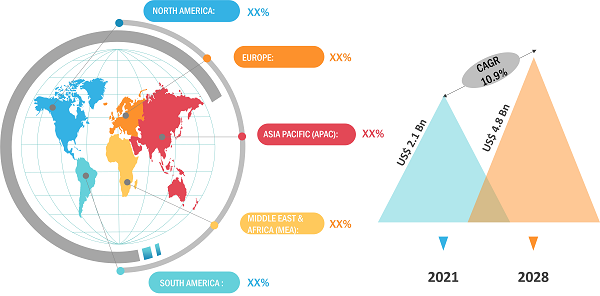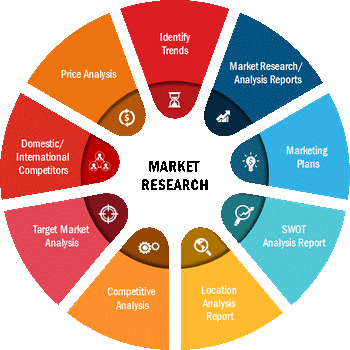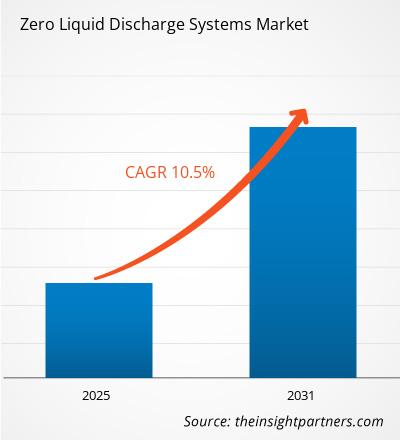بلغت قيمة سوق أنظمة تصريف السوائل الصفرية 2.1 مليار دولار أمريكي في عام 2021، ومن المتوقع أن تنمو بمعدل نمو سنوي مركب يبلغ 10.9% بين عامي 2021 و2031.
يهدف نظام تفريغ السوائل الصفري (ZLD) إلى إزالة جميع النفايات السائلة، مع ترك صفر تفريغ لأي نفايات صناعية أو سامة في النهاية. تركز أنظمة تصريف السوائل الصفرية على إعادة تدوير مياه الصرف الصحي اقتصاديًا، وبالتالي توفير المال وإفادة البيئة. أحد التطبيقات المهمة الأخرى لأنظمة تصريف السوائل الصفرية هو إمكانية استعادة الموارد التي قد تكون موجودة في مياه الصرف الصحي. يعد التخلص من السوائل تمامًا بمثابة عملية معالجة مياه الصرف الصحي التي تتكون من عكس التناضح، التأين الكهربائي الجزئي، والترشيح الفائق. تعد ندرة المياه واقتصاديات المياه واللوائح البيئية من بين العوامل التي تشجع على استخدام أنظمة تصريف السوائل الصفرية.
ديناميكيات السوق
إن التحسينات في جودة أنظمة تصريف السوائل الصفرية، وتنفيذ اللوائح البيئية الصارمة، وندرة المياه في جميع أنحاء العالم هي التي تقود السوق. ومع ذلك، فإن التكلفة العالية لتركيب وتشغيل أنظمة تفريغ السوائل الصفرية تحد من نمو السوق. من ناحية أخرى، من المرجح أن يُظهر القلق المتزايد بشأن التخلص من تركيزات المياه المالحة السامة في المحيطات فرصًا للنمو سوق أنظمة تفريغ السوائل الصفرية خلال فترة التوقعات.
يعد "تحليل السوق العالمي لأنظمة تفريغ السوائل الصفرية حتى عام 2031" دراسة متخصصة ومتعمقة للمواد الكيميائية والكيميائية. صناعة المواد مع التركيز بشكل خاص على تحليل اتجاهات السوق العالمية. يهدف التقرير إلى تقديم نظرة عامة على سوق أنظمة تصريف السوائل الصفرية مع تجزئة السوق التفصيلية حسب النظام والعملية وصناعة الاستخدام النهائي والجغرافيا. ومن المتوقع أن يشهد السوق نمواً مرتفعاً خلال الفترة المتوقعة. يقدم التقرير إحصائيات أساسية عن حالة السوق للاعبين الرائدين في السوق ويقدم الاتجاهات والفرص الرئيسية في السوق.
تقسيم السوق
ال يتم تقسيم السوق العالمية لأنظمة تفريغ السوائل الصفرية بناءً على النظام والعملية وصناعة الاستخدام النهائي. بناءً على النظام، يتم تقسيم السوق إلى أنظمة تفريغ سائل تقليدية صفرية وأنظمة تفريغ صفر سائل هجينة. من حيث العملية، يتم تقسيم السوق إلى المعالجة المسبقة والترشيح والتبخر والبلورة. استنادا إلى صناعة الاستخدام النهائي، يتم تقسيم السوق إلى الطاقة & أمبير؛ الطاقة والمواد الكيميائية & البتروكيماويات والأغذية& المشروبات والمنسوجات والأدوية وأشباه الموصلات& الإلكترونيات وغيرها.
< /span>
يقدم التقرير نظرة عامة مفصلة عن الصناعة، بما في ذلك الجوانب النوعية والكمية معلومة. ويقدم نظرة عامة وتوقعات لسوق أنظمة تفريغ السوائل الصفرية العالمية بناءً على القطاعات المختلفة. كما يوفر حجم السوق والتقديرات المتوقعة من عام 2021 إلى عام 2031 فيما يتعلق بخمس مناطق رئيسية - أمريكا الشمالية وأوروبا وآسيا والمحيط الهادئ (APAC) والشرق الأوسط وأفريقيا. أفريقيا (MEA)، وأمريكا الجنوبية. يتم تقسيم سوق أنظمة تصريف السوائل الصفرية في كل منطقة لاحقًا إلى البلدان والقطاعات المعنية. ويغطي التقرير التحليل والتوقعات الخاصة بـ 18 دولة على مستوى العالم، إلى جانب الاتجاهات والفرص الحالية السائدة في المنطقة.
من المنظور الإقليمي، سيطرت منطقة آسيا والمحيط الهادئ على سوق أنظمة تفريغ السوائل الصفرية بحصة سوقية تبلغ حوالي XX٪ في عام 2021. ويشهد سوق أنظمة ZLD في منطقة آسيا والمحيط الهادئ نموًا كبيرًا، بسبب ارتفاع الطلب من دول مثل مثل الهند والصين. وضعت هذه البلدان العديد من اللوائح الحكومية لتركيب أنظمة تصريف سائلة صفرية وتقليل تلوث المياه من خلال تنفيذ تقنيات معالجة المياه.يوضح الشكل أدناه اتجاه نمو الإيرادات في السوق العالمية لأنظمة تفريغ السوائل الصفرية
:
المصدر: تحليل The Insight Partners
يحلل التقرير العوامل التي تؤثر على سوق أنظمة تصريف السوائل الصفرية من جانبي الطلب والعرض ومواصلة تقييم ديناميكيات السوق، أي المحركات والقيود والفرص والاتجاهات المستقبلية. يقدم التقرير أيضًا تحليلاً شاملاً للقوى الخمس لبورتر، حيث يسلط الضوء على العوامل التي تؤثر على سوق أنظمة تصريف السوائل الصفرية في مناطق أوروبا وآسيا والمحيط الهادئ.
لقد أثر وباء كوفيد-19 بشكل خطير على الصحة العامة وكذلك على الاقتصاد العالمي. تشير الأدلة المتقاربة المستمدة من الجائحة والفاشيات السابقة والتجارب الخاضعة للرقابة إلى أن الفيروس موجود في مياه الصرف الصحي لعدة أيام، مما قد يؤدي إلى مخاطر صحية محتملة من خلال مسارات مياه الصرف الصحي المتطايرة والمنقولة بالمياه. حاليًا، تقوم الشركات المصنعة الرائدة لأنظمة تفريغ السوائل الصفرية (ZLD) بتنفيذ مبادرات استراتيجية وعمليات إنتاج متقدمة تقنيًا لزيادة كفاءة الإنتاج وتحسين عروض منتجاتها.
اللاعبون في السوق
تغطي التقارير التطورات الرئيسية في سوق أنظمة تفريغ السوائل الصفرية بالإضافة إلى استراتيجيات النمو العضوي وغير العضوي. تركز العديد من الشركات على استراتيجيات النمو العضوي مثل إطلاق المنتجات والموافقات على المنتجات وبراءات الاختراع والأحداث. كانت استراتيجيات النمو غير العضوية التي شهدها السوق هي عمليات الاستحواذ والشراكات & التعاون. وقد مهدت هذه الأنشطة الطريق لتوسيع الأعمال التجارية وقاعدة العملاء من اللاعبين في السوق. من المتوقع أن يكون لدى اللاعبين في السوق فرص نمو مربحة في المستقبل مع الطلب المتزايد على أنظمة تفريغ السوائل الصفرية. فيما يلي قائمة ببعض الشركات العاملة في سوق أنظمة تفريغ السوائل الصفرية.
يتضمن التقرير أيضًا ملفات تعريفية لشركات سوق أنظمة تفريغ السوائل الصفرية الرئيسية، إلى جانب تحليل SWOT واستراتيجيات السوق. بالإضافة إلى ذلك، يركز التقرير على اللاعبين الرائدين في الصناعة بمعلومات مثل ملفات تعريف الشركة والمكونات والخدمات المقدمة والمعلومات المالية للسنوات الثلاث الماضية والتطورات الرئيسية في السنوات الخمس الماضية.
- Aquarion AG
- GE Water & تقنيات المعالجة
- GEA Group AG
- Petro Sep Corporation
- US Water Services, Inc.
- Veolia Water Technologies
يتكون فريق البحث والتحليل المخصص لدى Insight Partner من محترفين ذوي خبرة يتمتعون بخبرة إحصائية متقدمة ويقدم خيارات تخصيص متنوعة في الدراسة الحالية.
- التحليل التاريخي (سنتان)، السنة الأساسية، التوقعات (7 سنوات) مع معدل النمو السنوي المركب
- تحليل PEST و SWOT
- حجم السوق والقيمة / الحجم - عالميًا وإقليميًا وقطريًا
- الصناعة والمنافسة
- مجموعة بيانات Excel


- GMP Cytokines Market
- Extracellular Matrix Market
- Sleep Apnea Diagnostics Market
- Nuclear Decommissioning Services Market
- Water Pipeline Leak Detection System Market
- Vertical Farming Crops Market
- Piling Machines Market
- Microcatheters Market
- Advanced Planning and Scheduling Software Market
- Smart Grid Sensors Market

Report Coverage
Revenue forecast, Company Analysis, Industry landscape, Growth factors, and Trends

Segment Covered
This text is related
to segments covered.

Regional Scope
North America, Europe, Asia Pacific, Middle East & Africa, South & Central America

Country Scope
This text is related
to country scope.
الأسئلة الشائعة
The Zero Liquid Discharge Systems Market Size and Forecasts (2021 - 2031), Global and Regional Share, Trends, and Growth Opportunity Analysis Report Coverage:by System (Conventional Zero Liquid Discharge Systems, Hybrid Zero Liquid Discharge Systems); Process (Pretreatment, Filtration, Evaporation, Crystallization); End-Use Industry (Energy and Power, Chemicals and Petrochemicals, Food and Beverages, Textiles, Pharmaceuticals, Semiconductors and Electronics, Others) , and Geography (North America, Europe, Asia Pacific, and South and Central America) is estimated to witness a CAGR of 10.5% from 2023 to 2031
Some of the customization options available based on the request are an additional 3–5 company profiles and country-specific analysis of 3–5 countries of your choice. Customizations are to be requested/discussed before making final order confirmation, as our team would review the same and check the feasibility.
The report can be delivered in PDF/PPT format; we can also share excel dataset based on the request.
The major factors driving the zero liquid discharge systemmarket are: Increasing Water Scarcity and Resource Management
Aquarion AG, Aquatech International LLC, GEA Group AG, H2o GmbH, Ide Technologies, Petro Sep Corporation, Praj Industries Ltd., U.S. Water Services, Inc., Veolia Water Technologies, Fluence Corporation Limited
The List of Companies
1.Aquarion AG
2.Aquatech International LLC
3.GE Water and Process Technologies
4.GEA Group AG
5.H2o GmbH
6.Ide Technologies
7.Petro Sep Corporation
8.Praj Industries Ltd.
9.U.S. Water Services, Inc.
10.Veolia Water Technologies
The Insight Partners performs research in 4 major stages: Data Collection & Secondary Research, Primary Research, Data Analysis and Data Triangulation & Final Review.
- Data Collection and Secondary Research:
As a market research and consulting firm operating from a decade, we have published and advised several client across the globe. First step for any study will start with an assessment of currently available data and insights from existing reports. Further, historical and current market information is collected from Investor Presentations, Annual Reports, SEC Filings, etc., and other information related to company’s performance and market positioning are gathered from Paid Databases (Factiva, Hoovers, and Reuters) and various other publications available in public domain.
Several associations trade associates, technical forums, institutes, societies and organization are accessed to gain technical as well as market related insights through their publications such as research papers, blogs and press releases related to the studies are referred to get cues about the market. Further, white papers, journals, magazines, and other news articles published in last 3 years are scrutinized and analyzed to understand the current market trends.
- Primary Research:
The primarily interview analysis comprise of data obtained from industry participants interview and answers to survey questions gathered by in-house primary team.
For primary research, interviews are conducted with industry experts/CEOs/Marketing Managers/VPs/Subject Matter Experts from both demand and supply side to get a 360-degree view of the market. The primary team conducts several interviews based on the complexity of the markets to understand the various market trends and dynamics which makes research more credible and precise.
A typical research interview fulfils the following functions:
- Provides first-hand information on the market size, market trends, growth trends, competitive landscape, and outlook
- Validates and strengthens in-house secondary research findings
- Develops the analysis team’s expertise and market understanding
Primary research involves email interactions and telephone interviews for each market, category, segment, and sub-segment across geographies. The participants who typically take part in such a process include, but are not limited to:
- Industry participants: VPs, business development managers, market intelligence managers and national sales managers
- Outside experts: Valuation experts, research analysts and key opinion leaders specializing in the electronics and semiconductor industry.
Below is the breakup of our primary respondents by company, designation, and region:

Once we receive the confirmation from primary research sources or primary respondents, we finalize the base year market estimation and forecast the data as per the macroeconomic and microeconomic factors assessed during data collection.
- Data Analysis:
Once data is validated through both secondary as well as primary respondents, we finalize the market estimations by hypothesis formulation and factor analysis at regional and country level.
- Macro-Economic Factor Analysis:
We analyse macroeconomic indicators such the gross domestic product (GDP), increase in the demand for goods and services across industries, technological advancement, regional economic growth, governmental policies, the influence of COVID-19, PEST analysis, and other aspects. This analysis aids in setting benchmarks for various nations/regions and approximating market splits. Additionally, the general trend of the aforementioned components aid in determining the market's development possibilities.
- Country Level Data:
Various factors that are especially aligned to the country are taken into account to determine the market size for a certain area and country, including the presence of vendors, such as headquarters and offices, the country's GDP, demand patterns, and industry growth. To comprehend the market dynamics for the nation, a number of growth variables, inhibitors, application areas, and current market trends are researched. The aforementioned elements aid in determining the country's overall market's growth potential.
- Company Profile:
The “Table of Contents” is formulated by listing and analyzing more than 25 - 30 companies operating in the market ecosystem across geographies. However, we profile only 10 companies as a standard practice in our syndicate reports. These 10 companies comprise leading, emerging, and regional players. Nonetheless, our analysis is not restricted to the 10 listed companies, we also analyze other companies present in the market to develop a holistic view and understand the prevailing trends. The “Company Profiles” section in the report covers key facts, business description, products & services, financial information, SWOT analysis, and key developments. The financial information presented is extracted from the annual reports and official documents of the publicly listed companies. Upon collecting the information for the sections of respective companies, we verify them via various primary sources and then compile the data in respective company profiles. The company level information helps us in deriving the base number as well as in forecasting the market size.
- Developing Base Number:
Aggregation of sales statistics (2020-2022) and macro-economic factor, and other secondary and primary research insights are utilized to arrive at base number and related market shares for 2022. The data gaps are identified in this step and relevant market data is analyzed, collected from paid primary interviews or databases. On finalizing the base year market size, forecasts are developed on the basis of macro-economic, industry and market growth factors and company level analysis.
- Data Triangulation and Final Review:
The market findings and base year market size calculations are validated from supply as well as demand side. Demand side validations are based on macro-economic factor analysis and benchmarks for respective regions and countries. In case of supply side validations, revenues of major companies are estimated (in case not available) based on industry benchmark, approximate number of employees, product portfolio, and primary interviews revenues are gathered. Further revenue from target product/service segment is assessed to avoid overshooting of market statistics. In case of heavy deviations between supply and demand side values, all thes steps are repeated to achieve synchronization.
We follow an iterative model, wherein we share our research findings with Subject Matter Experts (SME’s) and Key Opinion Leaders (KOLs) until consensus view of the market is not formulated – this model negates any drastic deviation in the opinions of experts. Only validated and universally acceptable research findings are quoted in our reports.
We have important check points that we use to validate our research findings – which we call – data triangulation, where we validate the information, we generate from secondary sources with primary interviews and then we re-validate with our internal data bases and Subject matter experts. This comprehensive model enables us to deliver high quality, reliable data in shortest possible time.

 احصل على عينة مجانية لهذا التقرير
احصل على عينة مجانية لهذا التقرير